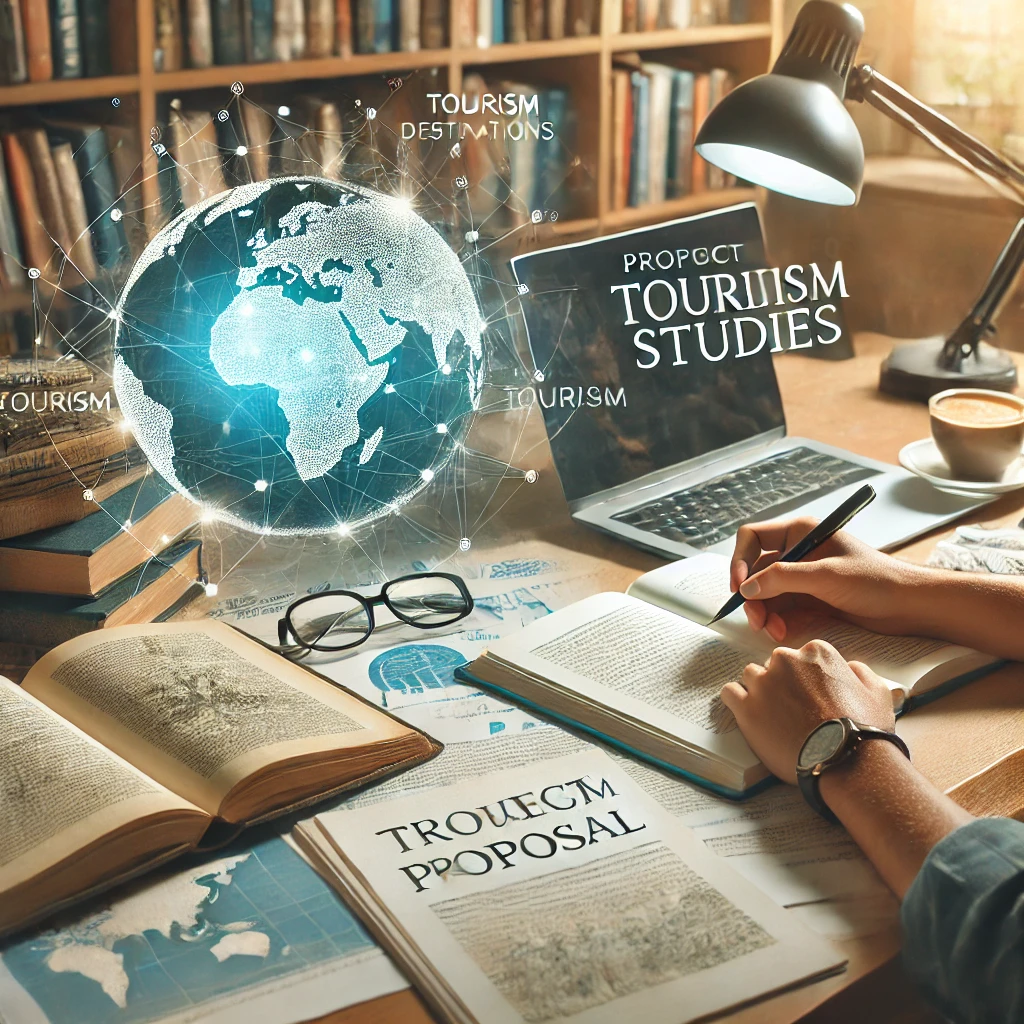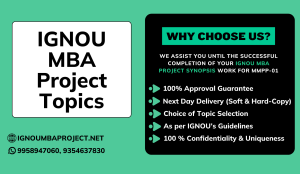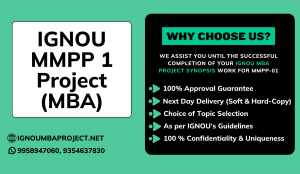An IGNOU BTS Project refers to the project work that is part of the Bachelor of Tourism Studies (BTS) program offered by the Indira Gandhi National Open University (IGNOU). The BTS program is designed to provide students with an in-depth understanding of the tourism industry, focusing on areas like travel, hospitality, tourism management, and sustainable tourism practices.
The IGNOU BTS project is a significant component of the program, allowing students to apply their theoretical knowledge to real-world tourism issues. It typically involves extensive research on a specific topic related to tourism, hospitality, or travel management. The project encourages students to explore aspects like destination management, eco-tourism, cultural heritage preservation, and the economic impact of tourism on local communities.
Have you clearly defined the main question or objective of your IGNOU BTS Project?
Yes, clearly defining the main question or objective of your research is one of the most critical steps in developing a successful IGNOU BTS project proposal.
Steps to Define the Main Research Question or Objective:
Identify a Relevant Topic:
- Begin by selecting a topic that is relevant to contemporary concerns or advances in the tourist sector, such as sustainable tourism, digital transformation in tourism, or the influence of tourism on local communities.
Narrow Down Your Focus:
- Narrow down the broader topic to a specific component or problem. For example, if you’re interested in sustainable tourism, you could focus on eco-tourism in a specific location or assess the effectiveness of government laws that encourage sustainable behaviors.
Formulate the Research Question:
- Your research question should be clear, concise, and researchable. For example:
- “How does eco-tourism impact the livelihoods of local communities in X region?”
- “What are the challenges faced by small tourism businesses in adopting digital marketing strategies?”
Ensure Feasibility:
- Make sure that the research question is feasible in terms of available resources, time, and access to data. Ensure that you can realistically collect and analyze data to answer the question.
State the Objective Clearly:
- Your objective should follow the question, stating what your research aims to achieve.
Sample of IGNOU BTS Project topics
- Study Of Culture, Arts And Crafts In Madhya Pradesh, India
- Potentials And Attractions Of Pilgrimage Tourism In Delhi
- To Study Of Ancient Monuments And Cultural Heritage Sites In Delhi
- Increase In Tourism Of Kerala
- To Study Of Carpet Weaving Industry Of Kashmir
- A Study To Explore The Culture And Tourist Destinations In Kashmir Valley
- Historical Background Of The Culture And Tradition Of The Kashmiri Pandits
- To Explore The Culture And Heritage Of Jammu Dogras
- To Explore The Art And Culture In Ladakh
- Rites, Rituals And Social Custom Among Kashmiri Hindus Of India
- The Traditional Music Of Kashmir
How does your topic contribute to the existing body of knowledge in tourism?
Here’s a structured approach:
1. Addresses a Knowledge Gap
The project addresses under-researched areas in tourism, bringing new insights. For example, if you’re researching sustainable tourism practices, your findings could highlight local community involvement in sustainability efforts, which is often disregarded in current research.
2. Builds on Previous Research
Your research expands and strengthens previous studies, providing fresh viewpoints. If earlier research has looked into the impact of digital marketing on tourism, your project could add depth by focusing on specific platforms or a particular region.
3. Provides Contextual Understanding
Contributes region-specific data that can be used to other similar situations. If your project focuses on rural tourism development in India, it contributes to a better knowledge of rural tourist potential in developing countries and provides lessons for other locations.
4. Introduces New Methodological Approaches
If your research employs novel approaches, such as big data analytics or social media sentiment analysis, it contributes new research procedures into tourist studies.
5. Policy and Practical Implications
Your study makes practical recommendations to stakeholders (such as tourism boards, local governments, and hospitality enterprises) and adds to policymaking, thereby boosting the sector’s sustainability or profitability.
Are you planning to conduct field surveys, interviews, or secondary data analysis?
When planning your IGNOU BTS Project, it’s essential to clearly define your data collection methods to ensure that you gather reliable and relevant information to address your research questions.
1. Field Surveys:
- Purpose: Field surveys involve collecting data directly from the target population (e.g., tourists, local residents, or tourism businesses) using structured questionnaires. This method is ideal for gathering quantitative data.
- When to Use: This method is useful when you need to understand tourist behavior, satisfaction levels, or the effectiveness of tourism policies in a specific location.
- Example: If your topic is “Tourist Satisfaction with Eco-tourism Destinations,” you could conduct surveys at eco-tourism sites to gather feedback from visitors about their experiences.
- Challenges: It can be time-consuming, requires significant planning for data collection, and the sample size must be large enough to ensure statistical significance.
2. Interviews:
- Purpose: Interviews (either structured or unstructured) allow you to obtain qualitative data by asking open-ended questions to individuals who have direct experience or expertise in the area you are studying.
- When to Use: This method is ideal when you want to gather in-depth insights from industry experts, tourists, or local stakeholders (e.g., tourism officers, business owners, or residents). Interviews are particularly useful for exploring perceptions, experiences, and challenges.
- Example: If your project is on “Challenges in Sustainable Tourism Development,” interviews with local government officials, tourism business owners, and community leaders will provide rich insights.
- Challenges: Interviews require time for preparation, transcription, and analysis. Also, they are subject to interviewer bias and may not always be representative if the sample size is too small.
3. Secondary Data Analysis:
- Purpose: Secondary data analysis involves using existing data from various sources, such as government reports, industry publications, academic journals, or online databases. This method is great for quantitative research and exploring patterns over time.
- When to Use: Secondary data is useful when you have access to data sets, and your research doesn’t require primary data collection. It can provide insights into tourism trends, economic impact, and policy effectiveness.
- Example: If your research focuses on “Tourism’s Economic Contribution to Rural Areas,” you could use government statistics, industry reports, or research studies to analyze existing data on income, employment, and tourist numbers.
- Challenges: Secondary data may not fully align with your specific research objectives, and you may not have control over the accuracy or completeness of the data.
Combination of Methods:
- Mixed-Methods Approach: Often, combining several strategies produces the best results. For example, field surveys could be used to acquire quantitative data on tourist satisfaction, whereas interviews could help you understand why certain satisfaction levels exist. Secondary data can supplement your findings by revealing wider trends or historical context.
Check Out: Structured, Strategic, Successful—IGNOU MCom Project Help!
Is the scope of your IGNOU BTS Project manageable within the time frame and available resources?
Ensuring that the scope of your IGNOU BTS project is manageable within the time frame and available resources is crucial to the success of your research. You want to avoid an overly ambitious project that you can’t complete within the given constraints. Here’s how to assess and ensure your project is feasible:
1. Define a Clear and Focused Topic:
- Focus down the Scope: Begin with a wide topic and then focus it down to a specific research question or target. For example, rather than covering the entire tourism business, concentrate on a specific component such as “Tourist Satisfaction in Eco-tourism Destinations in a Specific Region” or “The Impact of Social Media on Domestic Tourism in India”. A targeted topic will allow you to keep within the constraints of your time and resources.
2. Set Realistic Objectives:
- Clear Research Objectives: Your research objectives should be consistent with the scope of your study. Define what you want to achieve and prioritize the most crucial components.
3. Time Management:
- Research Time Frame: Divide your duties (literature review, data collecting, analysis, and writing) into manageable chunks and assign time to each. Think about how long each phase will take.
- Time for Data Collection: If you’re conducting surveys or interviews, allow adequate time to recruit participants, gather replies, and analyze the data. If you don’t have much time, avoid long data collection techniques.
4. Resource Availability:
- Data Access: Make sure you have access to the information you need. If you are using primary data (such as surveys or interviews), make sure you can reach the intended audience. If you’re using secondary data, make sure it’s up to date.
- Tool and Software: Make sure you have access to and are familiar with the tools needed for data gathering and analysis (for example, survey platforms, statistical software).
5. Budget Considerations:
- Funding: If your research requires financial resources (for travel, data collection materials, etc.), check that your budget is feasible. You may also need to factor in costs like printing surveys or reimbursing interviewees.
6. Supervision and Support:
- Consult Your Supervisor: Check in with your project supervisor on a regular basis to make sure you’re on track. They can offer useful insights into scope, focus, and viability.
- Seek feedback early: If you are unsure whether the scope is too large, seek feedback early on. Supervisors can assist you fine-tune your aims and make your study more doable.
Is your IGNOU BTS Project clear, well-structured, and free of errors?
A well-crafted proposal not only communicates your ideas effectively but also demonstrates your ability to plan and organize your research. Here’s how to make sure your BTS Project is in top shape:
1. Clear and Concise Writing
- Avoid Overcomplicated Language: Use straightforward language that is easy to grasp. Avoid jargon unless it is absolutely necessary, and describe any technical words that may be unfamiliar to everyone.
- State your purpose clearly: Make it clear from the start what your research’s goals are. Make sure your research question and objectives are easy to find and understand.
- Be specific: Avoid being ambiguous or overly generic. Provide specific information about your study topic, methodology, and projected outcomes.
2. Well-Structured Proposal
A well-organized proposal has a clear flow of information. Make sure to structure it in the following sections:
- Introduction: Briefly introduce your research topic, its relevance, and the problem you plan to address.
- Research Questions/Objectives: Clearly define your research question or objectives. What do you intend to explore, and why?
- Literature Review: Provide a brief overview of the existing research on the topic. This will establish the context for your project and show that you have a strong understanding of the field.
- Methodology: Explain the methods you will use to conduct your research, such as surveys, interviews, secondary data analysis, etc. Be specific about how you will collect and analyze data.
- Timeline: Outline a realistic timeline for your project, including key milestones (e.g., literature review, data collection, analysis, writing).
- Resources Needed: Mention the resources you need (data sources, tools, funds, etc.) to complete your research successfully.
- Conclusion: Briefly summarize your project’s significance and its potential contribution to the field.
3. Consistency in Formatting
- Headings and Subheadings: To make your proposal easier to navigate, format your headings and subheadings consistently.
- Fonts and spacing: For clarity, use a readable font (e.g., Times New Roman, Arial) and suitable spacing (typically 1.5 or double-spaced).
- Page numbers and references: Ensure that your proposal is paginated and prepared in accordance with your university’s rules. Include citations for any sources you use.
4. Proofreading and Error-Free Content
- Grammar and Spelling Check: Proofread your proposal carefully to ensure that there is no grammar or spelling issues. Grammarly and other tools can help you catch mistakes.
- Clear Sentence Structure: Make your sentences simple and succinct. Avoid using long, convoluted statements that could confuse the reader.
- Citations: If you refer to any research, publications, or papers, make sure you correctly mention them using the relevant citation style (e.g., APA, MLA).
5. Review and Feedback
- Get Feedback: Before submitting your proposal, ask a peer, colleague, or mentor to review it. Fresh eyes may catch errors or suggest improvements that you may have missed.
- Supervisors’ Expectations: If possible, review the guidelines or expectations provided by your supervisor or department to ensure your proposal aligns with what they’re looking for.
Conclusion
In conclusion, crafting an effective IGNOU BTS project proposal requires careful planning, clear objectives, and an organized approach. By selecting a relevant and focused research topic, formulating a concise research question, and ensuring the feasibility of your project within the available time and resources, you set yourself up for success. In fact, a well-organized and error-free proposal will indicate and ensure that your project has a meaningful contribution to the existing tourism knowledge body. Be it a field survey, interviews, or secondary data analysis, the combination of these will strengthen your findings with valuable insights.
Remember that proper communication with your supervisor and appropriate feedback in the process will help refine your proposal and guide you toward the achievement of your academic goals in the BTS program. This approach to project development is much like the meticulous planning required in any academic project, such as an IGNOU MBA project, where well-defined objectives and structured research ensure success.






